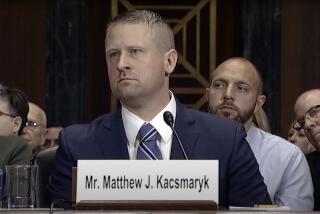Law’s Empire by Ronald Dworkin (Harvard University: $20; 452 pp.)
- Share via
Ronald Dworkin is the closest thing to a household name that Anglo-American legal philosophy has produced since Jeremy Bentham and John Stuart Mill first put quill to parchment in search of utilitarianism and the liberal ideal. In 1968, while still a relatively unknown Yale Law School professor, Dworkin was offered the prestigious chair in jurisprudence at Oxford University--a position he had not even applied for but which he enthusiastically accepted. Since then, he has been on a ceaseless quest to reveal the internal logic and unique moral dimensions of legal reasoning.
His latest book, “Law’s Empire,” is a jurisprudential epic. In it, Dworkin attempts to tie the loose threads of his earlier writings on such diverse topics as civil disobedience, affirmative action and law and economics into an integrated theory of law.
Dworkin begins with the self-evident: “It matters how judges decide cases.” It matters not only to those “unlucky or litigious or wicked or saintly enough to find themselves in court,” but to the public at large. Our courts have the power to overrule the most popular decisions of the other branches of government, and they often have the last word on such gripping controversies as whether states may execute murderers, prohibit abortions or require school prayer.
But while no department of state is more important than the judiciary, none is so thoroughly misunderstood. The popular view--that law exists as a “plain fact” waiting to be recited by judges--is woefully deficient. In “hard cases,” lawyers and judges often disagree sharply over what the law is.
“How,” asks Dworkin, “should we decide what the law commands when the law books are silent or unclear or ambiguous?” His answer is that such cases call for “constructive interpretation,” a process which he defines as “imposing purpose on an object or practice in order to make of it the best possible example of the genre to which it belongs.” According to Dworkin, legal reasoning, which takes the law as its object, is just such an exercise.
Dworkin is not the first to scrutinize the nature of legal reasoning. One prevalent theory, “conventionalism,” holds that legal practice is simply a matter of respecting and enforcing what the established conventions of a system (statutes, court decisions, etc.) say it is. Another, more skeptical school of thought, pragmatism, denies that judges resolve cases on the basis of fundamental rights and argues instead that legal practice is best understood as an instrument for achieving social goals.
Dworkin rejects each of these conceptions as inadequate in explaining how judges deal with hard cases. In their place, he develops the notion of Law as Integrity, which asks judges to assume that the law is structured by a coherent set of moral principles about justice, fairness and procedural due process. Judges are called on to enforce those principles in novel and difficult cases that come before them.
Deciding hard cases, however, remains an arduous process. Any judicial decision must fit both past legal practice in the area of law under consideration and legal practice as a whole. The adjudicative task is thus broad and abstract, and there may be more than one plausible way to decide a hard case. When two or more eligible interpretations of the applicable law exist, judges must choose among them by asking which shows the community’s legal standards in the best light from the standpoint of justice and fairness.
Dworkin fleshes these ideas out in a lengthy examination of four historical hard cases, including the famous civil rights decisions, Brown v. Board of Education. Legally, Brown was a difficult case because the Supreme Court was confronted on the one hand with past precedent (Plessy v. Ferguson) upholding racial segregation in general, and on the other with a series of its own previous opinions in which it had invalidated segregated practices in certain law schools and colleges.
The Court’s ultimate decision to overturn the “separate but equal” doctrine in public schools resulted from a wide-ranging interpretation not only of the legislative history and past judicial construction of the 14th Amendment, but of the moral and practical importance of education in American life.
Dworkin believes that cases like Brown hold the key to understanding our entire legal system. But even if Brown can faithfully be read as a real-life application of Law as Integrity, the question of how well Dworkin’s model comports with the daily work of the average judge is a troubling one, which Dworkin never successfully addresses. At times, he seems to say that his model merely provides a better fit with actual legal practice than any competitor; at other times, he claims that all judges devise, albeit unconsciously, working theories of law, which presumably approximate his own. At still other junctures, however, Dworkin recognizes the abundance of badly reasoned judicial decisions and simply seems to argue that judges would perform their duties better and more wisely if only they adopted his methodology.
Such uncertainty, which is compounded by Dworkin’s prolix and discursive style, will be sure to make this masterwork of interpretation the subject of interpretation itself for years to come.
More to Read
Sign up for our Book Club newsletter
Get the latest news, events and more from the Los Angeles Times Book Club, and help us get L.A. reading and talking.
You may occasionally receive promotional content from the Los Angeles Times.










